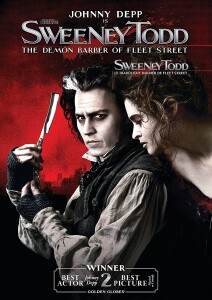 Craig Clarke wrote this review.
Craig Clarke wrote this review.
Attend the tale of Sweeney Todd.
His skin was pale and his eye was odd.
He shaved the faces of gentlemen
Who never thereafter were heard of again,
Did Sweeney,
Did Sweeney Todd,
The demon barber of Fleet Street.
I first encountered the wonder that is Sweeney Todd: The Demon Barber of Fleet Street on PBS (the nationally touring version with Angela Lansbury and George Hearn). With bloody murder, dark humor, and cannibalism, I knew immediately that this was a musical even I could get my head around. (Later, Little Shop of Horrors had a similar effect.)
I immediately bought the only CD copy I could find (highlights of the original cast recording with Lansbury and Len Cariou), and have been a fan ever since, especially of the morbidly funny centerpiece (and Act 1 closer) “A Little Priest,” wherein Todd and Mrs. Lovett wittily fantasize about what will be on her meat-pie shop’s menu:
“Is that squire on the fire?”
“Mercy, no, sir. Look closer, you’ll notice it’s grocer.”
“Looks thicker — more like vicar.”
“No, it has to be grocer, it’s green.”
Director Tim Burton’s film really does justice to this story of a barber returning to London after 15 years in prison to take revenge on the man who ruined his life. Johnny Depp is a surprisingly solid singer (he adds a rock and roll touch that is not unwelcome), and Helena Bonham Carter carries the more difficult role of Mrs. Lovett with surprising skill. Even Sacha Baron Cohen, whose “comedy” I don’t find funny at all, is a treat in a broad performance that works and allows him to use two different accents. (In an interview on the DVD, Bonham Carter states that she’s been a fan for decades and that, despite her relationship with the director, she still had to audition for the musical’s composer and lyricist, Stephen Sondheim.)
Visually, Sweeney Todd mixes light and dark brilliantly, as one might expect from Burton, whose filmography consists primarily of shades of gray. Also, even though several of the songs from the original are missing (and all of the choral pieces were cut from those included), the trimming works well on the screen. (The only song I really missed was “The Ballad of Sweeney Todd,” quoted at the beginning of this review.) This change results in an amount of music not overwhelming to people who don’t generally like musicals, such as the horror fans whose attention will be kept by the volume of blood spilled.
It works as a horror film, as a tragedy, as an oddball romance (of sorts), and best of all, it still works as a musical. Even Sondheim liked it, and he has notoriously disapproved of other films based on his work. I’m not likely to buy the soundtrack — the singing isn’t bad, but it’s by no means good enough to listen to by itself — but Burton’s Sweeney Todd has reinvigorated my love of the material, and that’s enough to recommend it to anyone.
(DreamWorks/Warner Bros., 2007)
